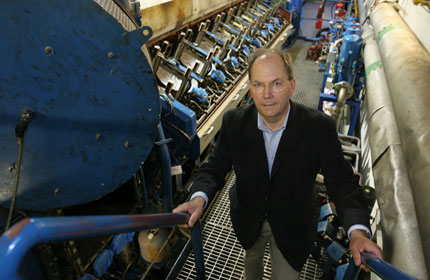
Mike Smith, Executive director of Southampton Geothermal Heating Company, in the engine room at the CHP plant.
Archive content: last updated 27 August 2007
Southampton is a true pioneer of sustainable energy. Having committed to implementing decentralised energy years before many other local authorities (some of whom are only just picking up the ball), the city now has several pioneering energy schemes:
Southampton district energy scheme
 Southampton district energy scheme is one of the largest commercially developed community heating and cooling networks in the UK. In the early 1980's, as part of the city's plan to become self-sustaining in energy, the council (led by Alan Whitehead, now the MP for Southampton Test) took advantage of a geothermal borehole commissioned by the Department of Energy, to examine the potential of geothermal heating in the UK. Due to insufficient resources in the geothermal aquifer, the Department of Energy decided not to proceed but Southampton took the decision to pioneer district heating, and carried on after entering into a ground breaking co-operation arrangement with Utilicom Ltd.
Southampton district energy scheme is one of the largest commercially developed community heating and cooling networks in the UK. In the early 1980's, as part of the city's plan to become self-sustaining in energy, the council (led by Alan Whitehead, now the MP for Southampton Test) took advantage of a geothermal borehole commissioned by the Department of Energy, to examine the potential of geothermal heating in the UK. Due to insufficient resources in the geothermal aquifer, the Department of Energy decided not to proceed but Southampton took the decision to pioneer district heating, and carried on after entering into a ground breaking co-operation arrangement with Utilicom Ltd.
In 1986, Southampton began pumping heat from the geothermal borehole through a district heating network. Over the years, several combined heat and power (CHP) engines and backup boilers for heating have been added, along with absorption chillers and backup vapour compression machines for cooling.
The scheme, which started with a single customer (the Civic Centre) now has thousands of customers. It provides heating and cooling to over a thousand residential properties, several large office buildings, a hospital, a health clinic, a university, a large shopping centre, a supermarket, several hotels, BBC television studios, one of Europe's largest shopping complexes, and a swimming and diving complex, among others.
The constantly growing scheme is in the process of commissioning a new large CHP plant to replace a smaller unit and will be adding a biomass boiler early in 2008.
A 725kWe CHP engine has recently been installed at the Royal South Hampshire Hospital as part of the scheme, which will guarantee the secure operation of the hospital supplying its heat and electricity. Any extra requirement for steam is provided by the district energy network and any excess is fed back into the network, to supply other properties.
Southampton's district energy network cost £7m to develop and now has annual sales of 40GWh of heat, 22GWh of electricity and 8GWh of cooling, with 11 kilometres of heating and cooling pipes. It saves over 12,000 tonnes of carbon emissions per year and is 85 per cent efficient (compared to an average of about 38 per cent for centralised power station). This high level of efficiency won it a Queen's Award for Sustainable Development in 2001 and a National Energy Efficiency Award in 2006. So decentralised energy isn't only cheaper, cleaner and more secure, it also comes with a certain prestige...
Holyrood community heating
 The Holyrood scheme, installed in 1996, is a small, standalone community heating scheme, covering 300 council owned flats in the centre of Southampton.
The Holyrood scheme, installed in 1996, is a small, standalone community heating scheme, covering 300 council owned flats in the centre of Southampton.
When the old heating system was found to be inadequate, a community heating scheme using CHP was decided as the best option for providing warmth for the tenants. Because the initiative has proved so reliable, it's also reduced the amount of maintenance needed on the tenants' heating systems, saving the council money and the need to access tenants homes.
As the larger Southampton city centre scheme expands, it will link up the Holyrood CHP unit with the city-wide network.
Millbrook district energy scheme
The planned Millbrook scheme - now ready for construction - will be one of the largest community heating developments in the UK. The CHP plant, site works, construction, network installation and property conversion for this super-scale scheme will only cost £55m. Over 4,000 households will be connected, including over 3,000 council owned dwellings and up to 1,000 privately owned homes. Eight schools and nine other buildings owned by the council's social services department will also be included, to be run by the not-for-profit Energy Services Company.
The CHP plant will produce 50MW of electricity that will be exported to the local distribution network: enough to power around 85,000 homes. It looks set to deliver almost 80 per cent of Southampton's pledged carbon emissions reductions, saving 170,000 tonnes per year.
Woolston Riverside Development
The city council and Utilicom, working with the South East England Development Agency and its development partners, are also planning to develop a district energy scheme on the eastern side of the River Itchen, over 15 hectares of the former Vosper Thorneycroft shipyard. It will be a mixed development and the intention is that its heating, electricity and chilling needs will all be provided on site from a large CHP scheme.
The future for Southampton
Southampton City Council is committed to decentralised energy. It plans to expand on its vision for district energy across the entire city and substantially reduce its greenhouse gas emissions by 2010.
Working in close co-operation with its private sector partner, Utilicom, it also plans to create a ring main around the city centre and will link up the city centre scheme with the Holyrood scheme. Eventually, it plans to introduce alternative technologies such as fuel cells and biogas from householders' kitchen waste, to heat and power the city. Ice storage, to help meet peak cooling needs, is also on the agenda.
Southampton city council now has a total of 45 years of commitment to decentralised energy.


